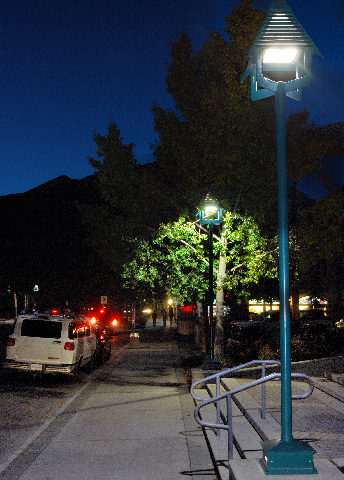Mirror, mirror on the wall. Where’s the greenest city of them all?

It shouldn’t shock you to hear that I receive a lot of pitches for this blog. (Which is a very good thing for ideas, actually, so keep them coming.)
One trend I’ve noticed is that many of what I’ll call the “real” green-tech efforts and experiments are very locally focused. This week, for example, I’ve had outreach about an LED installation in environmentally friendly little Banff (a town located in the breathtaking Canadian Rockies in Alberta)
Here’s a photo someone sent me.

Certainly, these projects are noteworthy. But when it comes to green technology, some cities are definitely greener than others. And (by the way) the greenest ones aren’t necessarily in the United States.
For the purpose of this column, I want to point out activities going on in San Jose, California, and in Singapore. What makes THESE cities worth emulating are not just their own activities to cut energy use and conserve natural resources but the infrastructure they’re both putting in place to encourage development of green technologies.
As part of its proposed Green Vision 15-year plan, San Jose has pledged to cut its per capita energy in half and move to alternative energy sources for 100 percent of its electrical power. Right now, clean and renewable sources contribute 12 percent to 13 percent of the city’s energy. Here’s some local coverage.
Collin O’Meara, the city’s CleanTech Policy Strategist, says there are already more than 130 “clean tech” companies located in San Jose, including those that are part of the Environmental Business Cluster. The city’s proposed plan calls for the creation of 25,000 in clean tech jobs and 50 million square feet of green buildings (including new construction and retrofit).
“For the same reason the previous waves of innovation have occurred her, the same perfect storm of inputs for the economy are here,” O’Meara says.
On the other side of the world, Singapore calls its agenda the Singapore Green Plan 2012, with a focus on environmental sustainability. Part of this push is its development of a Clean Energy and Technology Testbed (part of the Clean Energy Programme Office). The idea is that local companies can test their technologies before bringing them to the international market.
As part of its literature, Singapore reports that about 36 percent of the global clean tech research and development work being down originates in Asia. Singapore itself has attracted a number of alternative energy projects including a new solar manufacturing complex that Renewable Energy Corp. (a Norwegian company) has chosen to build in the region. Other companies that have located projects there include Germany’s Conergy (into solar), Australia’s Natural Fuel (a biofuels company) and Denmark’s Vestas Wind Systems.
Singapore also has established a diploma program at Singapore Polytechnic specifically focused on teaching the engineering skills associated with clean energy
So, where’s the greenest city of them all. Personally, I’m not sure it really matters. What does matter is that local communities and economic development agencies are showing leadership where certain federal agencies are not. So, I welcome you to share your thoughts about efforts you see happening around the world in your community specifically focused on green (or clean) tech—either through policies that cities are adoption or through investment activities they are encouraging. Or, best of all, maybe even both.